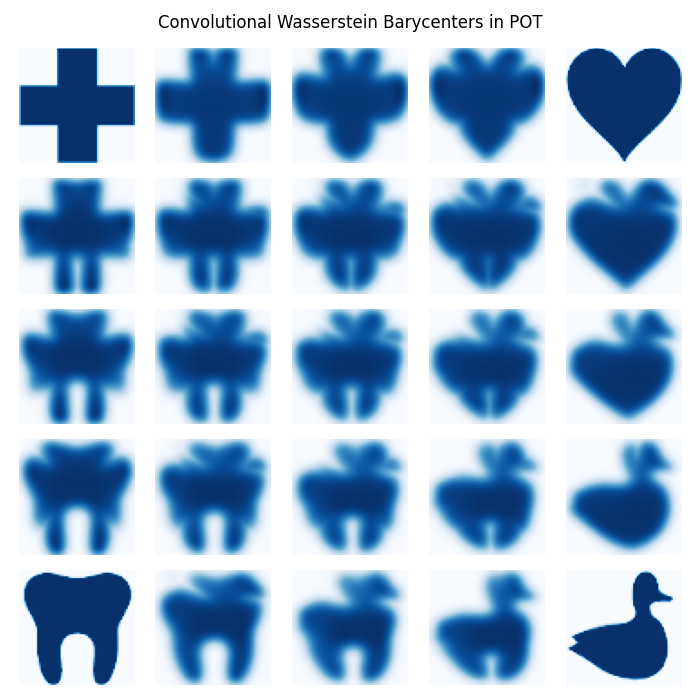Note
Go to the end to download the full example code.
Convolutional Wasserstein Barycenter example
This example is designed to illustrate how the Convolutional Wasserstein Barycenter function of POT works.
# Author: Nicolas Courty <ncourty@irisa.fr>
#
# License: MIT License
import os
from pathlib import Path
import numpy as np
import matplotlib.pyplot as plt
import ot
Data preparation
The four distributions are constructed from 4 simple images
this_file = os.path.realpath("__file__")
data_path = os.path.join(Path(this_file).parent.parent.parent, "data")
f1 = 1 - plt.imread(os.path.join(data_path, "redcross.png"))[::2, ::2, 2]
f2 = 1 - plt.imread(os.path.join(data_path, "tooth.png"))[::2, ::2, 2]
f3 = 1 - plt.imread(os.path.join(data_path, "heart.png"))[::2, ::2, 2]
f4 = 1 - plt.imread(os.path.join(data_path, "duck.png"))[::2, ::2, 2]
f1 = f1 / np.sum(f1)
f2 = f2 / np.sum(f2)
f3 = f3 / np.sum(f3)
f4 = f4 / np.sum(f4)
A = np.array([f1, f2, f3, f4])
nb_images = 5
# those are the four corners coordinates that will be interpolated by bilinear
# interpolation
v1 = np.array((1, 0, 0, 0))
v2 = np.array((0, 1, 0, 0))
v3 = np.array((0, 0, 1, 0))
v4 = np.array((0, 0, 0, 1))
Barycenter computation and visualization
fig, axes = plt.subplots(nb_images, nb_images, figsize=(7, 7))
plt.suptitle("Convolutional Wasserstein Barycenters in POT")
cm = "Blues"
# regularization parameter
reg = 0.004
for i in range(nb_images):
for j in range(nb_images):
tx = float(i) / (nb_images - 1)
ty = float(j) / (nb_images - 1)
# weights are constructed by bilinear interpolation
tmp1 = (1 - tx) * v1 + tx * v2
tmp2 = (1 - tx) * v3 + tx * v4
weights = (1 - ty) * tmp1 + ty * tmp2
if i == 0 and j == 0:
axes[i, j].imshow(f1, cmap=cm)
elif i == 0 and j == (nb_images - 1):
axes[i, j].imshow(f3, cmap=cm)
elif i == (nb_images - 1) and j == 0:
axes[i, j].imshow(f2, cmap=cm)
elif i == (nb_images - 1) and j == (nb_images - 1):
axes[i, j].imshow(f4, cmap=cm)
else:
# call to barycenter computation
axes[i, j].imshow(
ot.bregman.convolutional_barycenter2d(A, reg, weights), cmap=cm
)
axes[i, j].axis("off")
plt.tight_layout()
plt.show()

Total running time of the script: (0 minutes 20.726 seconds)